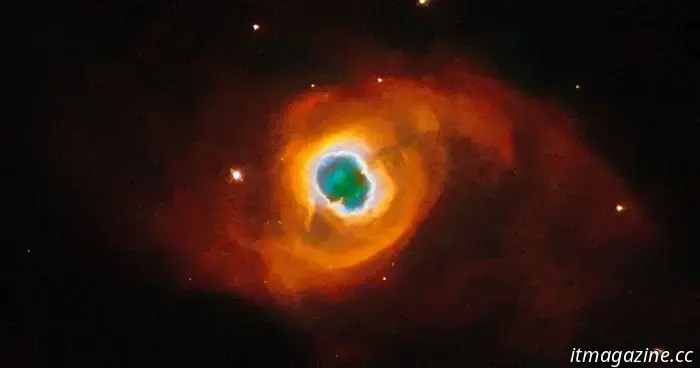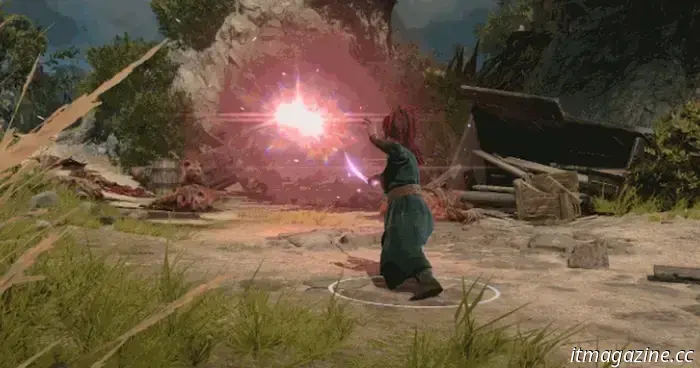
The stunning nebula captured in the last observation by one of Hubble’s instruments.
This image from the NASA/ESA Hubble Space Telescope showcases the planetary nebula Kohoutek 4-55.
When a star reaches the end of its lifespan and dies, it can produce a magnificent and destructive display, releasing an explosion of heat and light, while also giving rise to stunning new formations. A breathtaking new image from the Hubble Space Telescope illustrates the captivating outcomes of a star's demise, spotlighting a remarkable entity known as a planetary nebula.
The term "planetary nebula" can be misleading, as these formations bear no relation to planets. Early astronomers named them after observing round shapes through their telescopes, mistakenly believing they were distant planets. In reality, they are clouds of dust and gas formed by dying stars.
This specific planetary nebula, named Kohoutek 4-55, is situated within the Milky Way, approximately 4,600 light-years away. The varying colors in the image correspond to different elements expelled by the star as it perished.
According to NASA, "Planetary nebulae represent the spectacular final display at the conclusion of a giant star's life. Once a red giant star has depleted its available fuel and shed its last gaseous layers, its compact core contracts further, resulting in a final surge of nuclear fusion. The exposed core reaches extremely high temperatures, emitting ultraviolet light that energizes the vast clouds of gas expelled by the star. This ultraviolet light ionizes the atoms in the gas, causing the clouds to shine brightly. In this image, red and orange indicate nitrogen, green signifies hydrogen, and blue represents oxygen."
The structure of Kohoutek 4-55 is quite unusual, featuring several layers that appear as rings in different colors. This phase will be brief compared to a star's lifespan, as within tens of thousands of years, the glowing gas clouds will dissipate, leaving only the core of the deceased star, which will manifest as a white dwarf.
This image also serves as a poignant moment for Hubble, as it marks the last use of data from one of Hubble's instruments, the Wide Field and Planetary Camera 2. This instrument was superseded by the new Wide Field Camera 3 in 2009, but scientists have utilized data from the older instrument for the past 16 years, including some of its last data prior to its replacement, now processed with contemporary techniques to create this striking image.
Georgina has been the space writer at Digital Trends for six years, focusing on human space exploration and planetary matters.
Hubble explores the stunning remnants of a supernova.
The demise of massive stars is one of the universe's most dramatic events. When stars significantly larger than our sun exhaust their fuel and explode in colossal supernovae, these occurrences not only release vast amounts of energy but also alter the surrounding environment. As the explosion's shockwave travels millions of miles into space and collides with clouds of dust and gas, it can create intricate and beautiful structures known as supernova remnants. One of the most notable remnants is the Cygnus Loop, a bubble-shaped formation approximately 120 light-years across. Hubble captured an image of this remnant in 2020, and scientists are now using that Hubble data to investigate how these remnants evolve over time.
The James Webb Space Telescope has recently provided additional stunning images, this time showcasing the Ring Nebula in remarkable detail. First observed in the 18th Century and located about 2,500 light-years from Earth, the Ring Nebula's vibrant main ring comprises gas expelled by a dying star at its center.
A new image from the James Webb Space Telescope reveals the spectacular and distinctive Ring Nebula — a striking formation of dust and gas found in the constellation of Lyra. This nebula is popular among stargazers because it is oriented toward Earth, allowing us to appreciate its beautiful structure, and it is visible throughout summer from the Northern Hemisphere. It differs from the Southern Ring nebula, which Webb has also captured, but both belong to a category known as planetary nebulae. Located just 2,600 light-years away, the Ring Nebula, first observed in the 1770s, was initially mistaken for a planet. With advancements in technology, astronomers have come to understand it not as a planet, but as a cloud of dust and gas. Thanks to the detailed observations from space telescopes like Hubble and Webb, scientists have been able to discern more of its intricate structure. The nebula does not take the form of a simple sphere or blob but consists of a central, football-shaped body surrounded by rings of varied material.





Other articles
 Nautilus: Initial images, teaser, and sneak peek of the release date for Captain Nemo's journey.
AMC and AMC+ have unveiled the initial images, teaser, and premiere date for Nautilus, an adventure series inspired by 20,000 Leagues Under the Sea.
Nautilus: Initial images, teaser, and sneak peek of the release date for Captain Nemo's journey.
AMC and AMC+ have unveiled the initial images, teaser, and premiere date for Nautilus, an adventure series inspired by 20,000 Leagues Under the Sea.
 The uncertainty surrounding $90 Switch 2 games highlights just how flawed the internet has become.
There appears to be a widespread belief online that Nintendo Switch 2 games are priced at $90, but this isn't completely correct according to the information we have.
The uncertainty surrounding $90 Switch 2 games highlights just how flawed the internet has become.
There appears to be a widespread belief online that Nintendo Switch 2 games are priced at $90, but this isn't completely correct according to the information we have.
 The last patch for Baldur’s Gate 3 will be available in under a week.
The highly anticipated Patch 8 for Baldur's Gate 3 will arrive in a matter of days.
The last patch for Baldur’s Gate 3 will be available in under a week.
The highly anticipated Patch 8 for Baldur's Gate 3 will arrive in a matter of days.
 Microsoft asserts that the Edge browser has become 9% faster following an update.
Microsoft asserts that their Edge browser has become quicker than it was previously.
Microsoft asserts that the Edge browser has become 9% faster following an update.
Microsoft asserts that their Edge browser has become quicker than it was previously.
 Drop Review: An nearly flawless thriller that is entertaining and moves quickly.
Christopher Landon's Drop is entertaining, rapid-fire, and filled with excellent suspense, ranking it among Blumhouse's top films so far.
Drop Review: An nearly flawless thriller that is entertaining and moves quickly.
Christopher Landon's Drop is entertaining, rapid-fire, and filled with excellent suspense, ranking it among Blumhouse's top films so far.
 Looking for an additional display for your laptop? Purchase this screen extender for only $110.
The Kefeya S1 laptop screen extender allows you to set up a dual-monitor configuration for your laptop. It is currently available on Amazon for just $110 following a $70 price reduction.
Looking for an additional display for your laptop? Purchase this screen extender for only $110.
The Kefeya S1 laptop screen extender allows you to set up a dual-monitor configuration for your laptop. It is currently available on Amazon for just $110 following a $70 price reduction.
The stunning nebula captured in the last observation by one of Hubble’s instruments.
Hubble has documented the stunning consequences following the death of a star.
